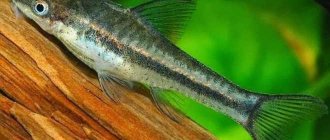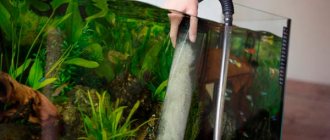Description and habitat
Catfish belong to the catfish family, and in their natural environment inhabit fresh water bodies throughout the planet. Catfish are rare in the seas. Most representatives of these fish prefer to live in the lower layers of the water column and are also nocturnal.
The size of aquarium catfish varies depending on the variety: both dwarf individuals and large catfish are found. In addition, catfish fish can be peaceful or aggressive, vegetarian or predatory, and even poisonous. A distinctive feature of all representatives is the absence of scales, although some species have bone plates or a shell instead.
Nowadays, the most popular in aquarium hobby are chain-linked catfish, although previously small armored catfish were considered favorites. The lifespan of aquarium catfish is 5-10 years; some species can survive safely in captivity for up to 15 years. Beginning aquarists who decide to buy these unpretentious and cute pets should remember that catfish do not eat garbage and other waste. They, like any other living beings, need care and proper nutrition.
Top most unpretentious aquarium fish
Now we can select those underwater pets who will not create problems when kept. There are also an incredible number of them, and most of them are compatible with each other.
Guppy
Perhaps it’s difficult to name them more popular. They are extremely tenacious and everyone involved in aquarium farming speaks about this. They belong to the poeciliaceae family. Their main feature is that females are significantly larger than males. The latter are not only smaller, but also have a brighter color. They have long veil fins, which attract the attention of beginners.
Guppies feel comfortable at a temperature of 18-28 degrees and in general are a model of unpretentiousness. But it is worth considering that they are viviparous, and therefore their population can grow rapidly if this is not monitored.
Swordtails
They are distinguished by a relatively calm and peaceful character. Males are smaller and slimmer than females and are distinguished by a sword-shaped appendage on their tail, which is where the name comes from. They can live comfortably in small aquariums. The optimal temperature is 22-26 °, but can withstand even 15 ° C. They belong to the same family as guppies. During spawning, females produce fry ready for life. Reproduction is possible both in a fish tank and in a general aquarium.
They feed on both plant and animal food. They will feel more comfortable if there is a lot of vegetation and shelter nearby. They are quite active and interesting, but it is better to install a lid or glass over the water so that the individuals do not accidentally jump out.
Catfish
This is a whole genus of ray-finned fish belonging to the catfish family. Therefore, it is impossible to clearly state the conditions of their detention. Some representatives grow no more than 10 cm, while others reach a length of 5 m.
Unpretentious fish include the genus Corydoras (shellfish). They are very peaceful and interesting. They swim in schools and arrange real hide and seek among themselves. Optimal conditions are 20-26 degrees, soft water with weak acidity.
You can also distinguish cockroaches . They need a larger aquarium, but they get along with almost everyone. Thanks to their shell, even predators are not afraid of them. They live for about 10 years. They prefer, like any catfish, the presence of shelters made of snags, stones and plants.
Well, and of course, don’t forget about ancistrus . They are not at all picky about conditions. Water 20-28° is suitable for them. They live for about 7 years and grow up to 10 cm. They love plant foods, and therefore you can even throw all sorts of vegetables (cucumbers, zucchini, pumpkin, dandelion leaves) with them. It is worth noting that this is a very useful inhabitant, which thoroughly cleans the glass and bottom if there are leftover food from neighbors.
Danio
They belong to the carp family. They are very popular due to the variety of colors. They are quite peaceful and live in flocks, which makes them look even more attractive. They grow small, 2-4 cm. They can be fed with both dry and frozen food. Temperature – 20-25°C.
Barbs
They amaze with their diversity. They are related to the zebrafish family. Very active and diverse. They love to have plenty of space to swim. Quite peaceful in nature, but incompatible with those neighbors that have long veiled fins.
Types of aquarium catfish
The catfish family is divided into many species, but only a few varieties are very popular among aquarists. Fans of the underwater world are especially fond of chain-linked catfish, which stand out among their relatives due to their bony plates. Before choosing one or another variety, you should familiarize yourself with the descriptions and preferences of different types of aquarium catfish:
- Pimelodidae - in their natural habitat they inhabit fresh rivers, therefore, when keeping these catfish in captivity, a clean and oxygenated aquatic environment is required. Pimelodaceae representatives do not have suckers, as a result of which aquarium fish lead an active lifestyle. The sizes of pimelod catfish vary from tiny - 5 cm, to giant - 60 cm.
- Agamiks are friendly and peace-loving creatures that grow up to 10 cm in length. Agamiks are nocturnal, so they are active in the aquarium at night, spending the day in shelters. They love to dig into the mud, raising turbidity and dust from the bottom, so it is best to keep agamixes in a tank with coarse soil.
- Pterygoplichts - these charming catfish for the aquarium are considered orderlies of the underwater world, and are able to get along well with other relatives. They feed on plant foods, and when there is a shortage of them, they switch to algae. When kept at home, pterygoplichths require planting a large number of plants.
- Ancistrus - these catfish are also called stickers. Ancistrus grow more than 10 cm in length and prefer to feast on plant foods. The body of the fish is covered with bony plates, the color is gray or brown with black or light markings.
- Corydoras are residents for a small aquarium. Among the species, speckled catfish and panda corydoras are especially popular. Representatives are distinguished by their peaceful nature - the Corydoras has excellent compatibility with the Kharacinovs and many other aquarium inhabitants. The color of the Corydoras is grayish-olive with dark markings, the abdomen is painted in a light shade.
- Loricaria - these unpretentious catfish belong to the armored catfish. Loricaria grow up to 12 cm in length, and the differences between males and females are clearly visible: males are slimmer and have a fleecy brush on their chest.
Varieties
The varieties of aquarium catfish simply amaze the imagination. However, do not be fooled by the fancy appearance of the fish; carefully study the description of the species you like. For example, some representatives may even be poisonous. The thorn prick, although not fatal to humans, can be quite painful. Find out what the most popular species of aquarium catfish are, as well as their photos with names right now.
Clarias
Do you have a large species aquarium? Then the spectacular catfish of the Clarias Angolan subspecies will become its excellent inhabitant. This voracious predator can reach the size of a teenager's hand. But it is very impressive thanks to its beautiful marbled color and large dorsal fin that stretches along the entire body. Not fussy about care and water quality.
Glass
The ghost catfish, or simply the so-called glass species, is perhaps the most peaceful and calm inhabitant of the aquarium. In addition, he is very unusual - he has an absolutely transparent body, through which one can see the internal organs and even the skeleton. However, it is very difficult to keep such a miracle of nature. Glass catfish are picky about water quality, get along only with peaceful neighbors, live exclusively in schools and are vulnerable to disease. The aquarium needs good vegetation.
We offer you to see in more detail what such an unusual fish looks like in the next video (Yuri Sakharov).
Flathead
The flathead catfish is described in appearance as an African killer whale. They have three pairs of whiskers and a well-developed adipose fin. Some of their species are distinguished by their bright colors, which is why they are loved by many aquarists. As for keeping them, these catfish are nocturnal predators, so they get along well in the company of large fish.
Brocade
This beautiful visitor from the Orinoco River got its name because of the black or brown spots that resemble brocade. They also have a large dorsal fin that resembles a sail, and their mouth is a single large sucker. Recently, this type has been very popular, but it causes a lot of trouble for beginners. He loves to scrape snags and eat vegetation, moves reluctantly and is very phlegmatic, clings to other sedentary fish. Not suitable for a small aquarium as it grows up to 35 cm in length.
Synodontis
This African subspecies gained particular popularity among our aquarists about 10-15 years ago. Many of its representatives are quite large, but peaceful and calm. Their large head with three pairs of long mustaches, as well as their torpedo-shaped body, attracts attention. They come in different colors, even black with polka dots - angelic synodont. But among beginners, small changelings are in particular demand - catfish that can swim belly up. They collect insects on the surface of the water and also perfectly clean the bottom.
Corridoras
Corydoras make up a fairly large group of catfish species. However, some of them, for example, those living in the waters of the Amazon, have not yet been sufficiently studied. Corydoras are very popular in freshwater aquariums, as they are peaceful and have an active behavior. It is especially interesting to watch them if they live in a flock. It can live calmly in muddy water, but they love a soft and slightly acidic environment.
Tarakatum
The Brazilian cockroach has a long body, and the male's chest is decorated with a powerful orange bone spike. These catfish love to build nests under the leaves of plants. Quite a pretty species, but due to the thorn it is rarely kept among beginners.
Ancistrus
Another Brazilian subspecies of dark catfish with light spots. They grow to medium sizes - approximately 14-15 cm and spend most of their time clinging to plants or the glass of the aquarium. It is phlegmatic towards other inhabitants, so it can easily get along in a common family and is suitable for an aquarium.
Loading …
Features of keeping catfish in an aquarium
The aquarium catfish is an unpretentious pet, whose maintenance will not cause difficulties even for a novice aquarist. First of all, in order for the fish to develop normally and grow to the required size, it is necessary to purchase a spacious reservoir, otherwise small catfish will grow in the aquarium. The bottom of the container should be wide, since catfish spend most of their lives at the bottom.
The size of the aquarium depends on the chosen species - if you plan to buy small catfish, then a volume of 50-100 liters will be sufficient. For large catfish, the minimum dimensions of the reservoir are 300 liters. Water parameters for keeping catfish:
- Temperature – 22-28C.
- Acidity – 6-7.5 pH.
- Hardness – up to 10 dH.
Water changes are performed weekly, updating 25% of the volume. Particular attention should be paid to the cleanliness of the aquarium - despite the fact that catfish help maintain order, pets do not eat garbage and waste, so the owner will have to take care of this.
Lighting for an aquarium with catfish is set to moderate - intense light will cause a lot of inconvenience to pets who prefer to lead a solitary nocturnal lifestyle. A large amount of live vegetation and shelters are placed in the tank so that shade-loving catfish can rest peacefully during the day.
When planting live plants, you should take into account the fact that most catfish are vegetarians and will happily gnaw at underwater flowers. To maintain the design of the tank, you can place artificial algae or the following types of plants:
- cryptocoryne;
- Echinodorus.
They are distinguished by a powerful root system, and can survive the attack of voracious catfish. The soil should be coarse-grained, since in an aquarium catfish happily “pick” in the soil, picking up dirt and debris from the bottom.
Interesting fact: some species of catfish can live up to 100 years in the wild.
Maintenance and care
Catfish are undemanding and hardy. Caring for them requires a wide, spacious aquarium. Basic rules for keeping catfish:
- The volume of the aquarium is chosen taking into account the size of the fish. For small pets, a capacity from 50 to 250 liters will be sufficient. Large fish will require housing with a volume of 300 liters or more.
- The water must be clean, filtered, and fresh. The optimal water temperature in an aquarium for catfish is in the range of 22-28°C.
- A home pool needs to be equipped with a good filtration system. Active enrichment of water with oxygen is also required. Thus, a directed flow will be created - a kind of “flow”.
- Mandatory weekly replacement of 1/4 to 1/2 of the amount of water in the aquarium.
- Fine and coarse soil with smoothed edges and sand are used.
- To shelter and rest fish, you need decor in the form of driftwood, grottoes, caves, and hollow tubes. Each fish must find a secluded corner.
- It should be taken into account that overly active or large individuals will constantly dig and turn over all the pebbles and sand at the bottom, damaging the algae. In this case, the plants need to be planted not in the ground, but in special containers.
- There is no need to equip a species aquarium with additional lighting.
For a full-fledged existence, in order to ensure proper care and maintenance of the Ancistrus catfish, you need a glass house with a capacity of 50 liters or more. The pet’s life will be comfortable if the owner complies with the requirements for water quality:
Aquarium soil
- temperature – 18-28°C;
- acidity – pH 6.0-7.5;
- hardness – dH up to 10°.
Water changes are done once a week, changing 1/4 of it. The bottom of the container is decorated with driftwood, grottoes, stumps, and caves. The presence of any aquatic vegetation is welcome. The soil usually consists of medium to large smooth pebbles. Lighting should be moderate.
The speckled catfish, the maintenance and care of which will also not cause any particular difficulties, will be grateful for a dwelling with a volume of 80 liters or more. Maintaining a stable state of water quality guarantees support for the life activity of catfish at the proper level:
- temperature – 15-25°C;
- acidity – pH 6.0-7.0;
- hardness – dH up to 4°.
This catfish prefers cool water, so during very hot summer periods it is necessary to prevent its temperature from rising above 25°.
The bottom is covered with a layer of sand, in which catfish love to burrow. You can use smooth fine gravel. Driftwood and stones are placed at the bottom as shelters and places to rest.
Aquarium with catfish
Nutrition
Feeding catfish is even simpler than keeping them. If your pets live in a tank with other fish, then you don’t have to feed the catfish at all - they will happily pick up leftover food from their neighbors, at the same time cleaning the area. When keeping only catfish fish, you can offer your wards the following products:
- Live and frozen food: bloodworms, tubifex, cyclops, shrimp, etc.
- Catfish tablets and flakes.
- Plant foods: cucumber, spinach, green peas, broccoli, etc.
Before serving, live food must be thoroughly washed, and plant food must be scalded with boiling water. If a predatory catfish lives in the tank, you should remember that small neighbors can become its lunch.
Interesting fact: hungry and predatory catfish living in their natural environment can drag even a dog to the bottom.
Compatibility
Most representatives of catfish, due to their friendly and peaceful nature, get along well with their relatives and other aquarium fish. Modest and quiet, catfish do not enter into conflicts or start fights, but with the wrong neighbors they can become victims. Introducing predatory fish, for example, astronotus, into the same aquarium together with catfish can lead to the death of the latter. It is also not recommended to place small and weak fish - guppies, neons and others - in a tank with predatory catfish, since pets may consider them food.
Interesting fact: the European catfish can weigh up to 400 kg, and is even capable of attacking people.
The best aquarium fish for a beginner in the carp family
Compared to the bright colors of people from tropical countries - the poeciliid family - carp fish have calmer and more monochromatic colors. Although some specimens are quite extravagant and are able to decorate an aquarium with their presence.
gold fish
There are many variations of this fish: ranchu, telescope, oranda, etc. But for a beginner, veiltails are the best choice. However, they are also considered one of the most beautiful representatives of their family.
Advantages:
- They are unpretentious in food and undemanding to water temperature, preferring a more comfortable +18 °C - the main thing is that there are no sudden changes;
- You can perform a partial water change in the aquarium - 10-15% every week;
- They are able to last a week without food if they have eaten properly before, although they will probably eat algae;
- With good care they can live up to 15 years.
Flaws:
- They need a large aquarium - 40-80 liters for each individual;
- Prone to overeating - you need to monitor the amount of food poured and always soak the dry mixture;
- Produce a lot of waste, which requires careful filtration of water;
- They do not tolerate proximity to more aggressive “brothers”, for example, comets.
Despite the variety and beauty of goldfish, only veil tails can be recommended to a beginner - all other options will require the aquarist to have experience and knowledge of the peculiarities of their maintenance.
Danio
These schooling and very active fish are the decoration of many aquariums, but they require enough space for their swims. Their color varies from crimson-red to sky blue, and their lifespan reaches up to 3 years. Due to their small size (about 5 cm) and the habit of living in schools, it is better to immediately populate zebrafish in an amount of at least 6 individuals.
Reproduction
Reproduction of catfish at home requires the construction of a spawning tank - a separate container with a volume of 30-70 liters. Having chosen young and strong representatives, the future parents are placed in a spawning tank, and the temperature of the aquatic environment is gradually lowered to 18C to stimulate spawning. It is important not to forget to install an aerator in the nursery and plant living plants. Shelters, snags and grottoes are placed at the bottom.
Before spawning, the wards are intensively fed. Breeding catfish in captivity is an exciting spectacle that has a certain romance. First, the male fish demonstrates beautiful courtship of the lady of his heart: circling around, delicately touching her with his antennae. Having interested the lady, the catfish invites her to the prepared corner for further reproduction. Spawning of catfish lasts 3-4 hours, and during this time the female lays up to 200 large eggs. After hatching, the parents are returned to the old aquarium, and the temperature of the aquatic environment in the spawning tank is increased to 27-28C.
Catfish fry mature in about 5-6 days, after which tiny babies with a yolk sac are born. During the first week of life, the fry gradually mature and begin to explore the waters in search of food. During this period, babies can already be fed with crushed food.
Aquarium catfish are not only charming and friendly pets that stand out from other residents in their appearance and lifestyle, but they are also one of the most unpretentious fish. Keeping catfish in captivity is easy, and even novice aquarists can do it, but before purchasing representatives of the catfish family, you should find out the individual preferences of the chosen variety.
What aquarium fish to buy for a beginner
1. Did your child persuade you to buy him an aquarium? First of all, get mollies or swordtails in it - caring for them is as easy as shelling pears.
2. Guppies are also suitable for the first experiment, but only the cheapest and “mongrel” ones - brightly colored imported fish often die after transplantation.
3. Do you want a round classic aquarium with a minimum of inhabitants? Then buy a gold veiled fish.
4. If you prefer active pets that are interesting to watch, you can choose zebrafish.
5. In a large aquarium, which also plays the role of interior decoration, it is better to keep cichlases. But you shouldn’t add other fish to them.
6. In a small room, a tall, flat aquarium with scalars will look no less beautiful.
7. If you often leave home for several days or do not have time to carefully care for your aquarium, it is better to choose representatives of the labyrinthine family. Gourami and cockerels will be able to live even in polluted water.
8. Whatever fish you choose, don’t forget to purchase cleaner catfish to help you. For beginners, the best choices are Corydoras and Sticky Ancistrus.











